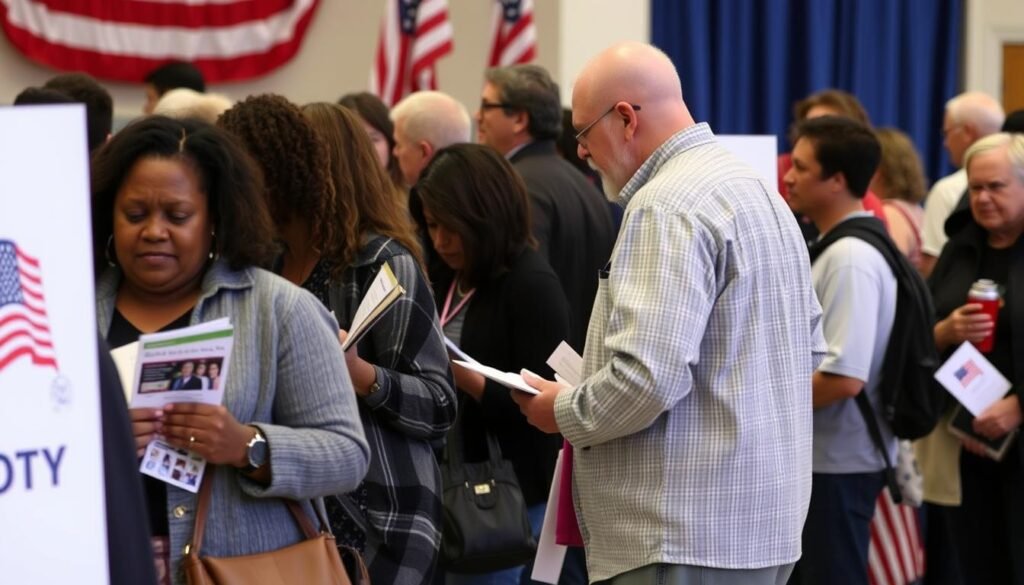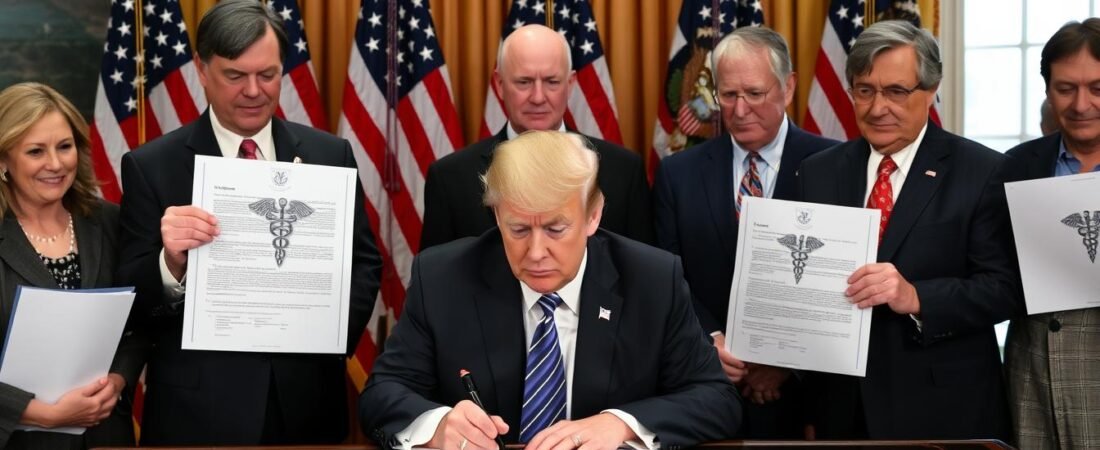The passage of President Donald Trump’s “One Big Beautiful Bill” marks a significant shift in American healthcare policy that could determine the outcome of the next election cycle. With over $1 trillion in Medicaid cuts and major tax policy changes, voters across the political spectrum are weighing how these healthcare reforms will affect their families, finances, and future access to medical care. As election season approaches, understanding the bill’s healthcare provisions has become essential for informed voting decisions.
Understanding the “Big Beautiful Bill” Healthcare Provisions
President Trump’s signature legislation contains significant healthcare policy changes that could reshape the American healthcare landscape.
The “One Big Beautiful Bill” combines tax reductions with substantial changes to healthcare programs that have served as safety nets for millions of Americans. The legislation contains approximately $4.5 trillion in tax cuts while implementing over $1 trillion in cuts to social welfare programs, particularly Medicaid.
According to the Congressional Budget Office (CBO), these changes would leave an estimated 17 million Americans without health coverage over the next decade. The bill establishes work requirements for Medicaid recipients for the first time in the program’s history and restricts states’ ability to finance their share of program costs.
Key Healthcare Components of the Bill
- Implementation of Medicaid work requirements nationwide
- Reduction in federal Medicaid funding by over $1 trillion
- Scaling back of food assistance programs for low-income families
- Expiration of Affordable Care Act subsidies at the end of the year
- Rollback of tax incentives supporting clean energy healthcare facilities
Historical Context: Healthcare Bills and Electoral Consequences
The political impact of major healthcare legislation has precedent throughout American history. From Medicare’s creation to the Affordable Care Act, healthcare policy changes have consistently influenced electoral outcomes.
When the Affordable Care Act passed in 2010, Democrats faced significant electoral losses in the subsequent midterms. However, after Republicans failed to repeal the ACA in 2017, Democrats scored major victories in the 2018 midterms by campaigning against those repeal efforts.
According to recent polling, healthcare policy remains an issue where voters trusted Kamala Harris more than Trump, even during the challenging 2024 election cycle for Democrats. This suggests the healthcare provisions in the “Big Beautiful Bill” could become a central campaign issue in upcoming elections.
| Major Healthcare Bill | Administration | Electoral Impact |
| Medicare/Medicaid Creation | Johnson (1965) | Helped Democrats maintain congressional majorities |
| Medicare Catastrophic Coverage Act | Reagan (1988) | Repealed after senior backlash |
| Failed Clinton Health Plan | Clinton (1993) | Republicans gained House majority in 1994 |
| Medicare Part D | Bush (2003) | Helped Bush win reelection in 2004 |
| Affordable Care Act | Obama (2010) | Democrats lost House in 2010 midterms |
| Failed ACA Repeal | Trump (2017) | Democrats gained House in 2018 midterms |
Understand How the Healthcare Bill Will Affect You
Download our comprehensive guide to learn exactly how the “Big Beautiful Bill” could impact your healthcare coverage, costs, and options before the next election.
How Healthcare Changes Will Impact Different Voter Groups

Medicaid Recipients and Low-Income Families
The bill’s $1 trillion reduction in Medicaid spending will significantly affect the 71 million Americans who currently depend on the program for health insurance. Work requirements will create new barriers to coverage, particularly for caregivers, seasonal workers, and those with chronic conditions that limit employment options.
Additionally, changes to the Supplemental Nutrition Assistance Program (SNAP) will impact approximately 4.7 million participants over the 2025-2034 period. These combined changes to safety net programs could mobilize affected voters in upcoming elections.
Middle-Class Families with Marketplace Insurance
The enhanced marketplace premium tax credits, first passed in 2021 and extended in 2022, are set to expire at the end of 2025. Without these credits, annual premiums in 2025 would increase by approximately $387 for the lowest-income enrollees and nearly $3,000 for people earning $60,240 or more.
The Urban Institute estimates that without these enhanced tax credits, four million more people would become uninsured. This could significantly impact voting patterns in swing states where marketplace enrollment is high.
Rural Communities and Hospital Access
Rural hospitals, already operating on thin margins, have warned that the funding patches included in the bill are insufficient to offset the impact of Medicaid cuts. Hospital closures could make it harder for people to access healthcare, even if they have insurance.
Senator Thom Tillis (R-NC) expressed concerns about these impacts, stating on the Senate floor: “The Medicaid provisions in this bill would be devastating to conservative voters in Republican-controlled states, particularly in rural areas where hospitals are already struggling to keep their doors open.”
State-by-State Healthcare Bill Election Impact
The healthcare provisions in the “Big Beautiful Bill” will have varying impacts across states, potentially reshaping electoral maps in upcoming elections. States that have not expanded Medicaid under the ACA will see particularly significant effects.
Swing State Spotlight: Pennsylvania
In Pennsylvania, a crucial battleground state, approximately 3.3 million residents rely on Medicaid for healthcare coverage. The state’s hospitals have warned that Medicaid cuts could force facility closures in rural areas where healthcare access is already limited.
Pennsylvania Hospital Association President Andy Carter noted, “These cuts would devastate our healthcare infrastructure at a time when many facilities are still recovering from the financial impacts of the COVID-19 pandemic. Voters will feel these changes directly in their communities.”
Non-Expansion States: Texas and Florida
Texas and Florida, which have not expanded Medicaid under the ACA, will face unique challenges under the new legislation. The 1.5 million very poor people in the “coverage gap” in these and other non-expansion states will remain uninsured, with no clear path to affordable coverage.
These states will also see disproportionate impacts from the expiration of enhanced marketplace subsidies, potentially creating new political pressures in traditionally Republican-leaning states.
Analyzing the Pros and Cons of the Healthcare Changes
Potential Benefits
- Reduced federal spending could help address national debt
- Work requirements may increase workforce participation
- Tax cuts could stimulate economic growth
- Increased state flexibility in program administration
- Potential for market-based healthcare innovations
Potential Drawbacks
- Estimated 17 million Americans losing health coverage
- Higher out-of-pocket costs for marketplace enrollees
- Increased uncompensated care costs for hospitals
- Potential rural hospital closures
- Widening health disparities across income levels

Healthcare economists have noted that the bill’s impacts will extend beyond those directly affected by Medicaid cuts. When people lose health insurance, they are more likely to skip regular medical checkups and end up in emergency rooms with serious conditions. Hospitals must provide this care regardless of ability to pay, passing those costs on to insured patients.
Dr. Katherine Baicker, Dean of the University of Chicago Harris School of Public Policy, explains: “The effects of the Republican budget bill are going to filter through the rest of the health care system and increase costs for everyone. In that sense, the legislation passage marks a new era for US health policy.”
Political Ownership of Healthcare Outcomes
For the past decade, US healthcare politics have followed what analysts call a “you break it, you buy it” rule. After the Affordable Care Act passed in 2010, Democrats saw their popularity plummet as Republicans successfully blamed premium increases on the new law. Democrats lost Congress in the 2010 midterms as a result.
Years later, as 44 million Americans gained coverage through the ACA and two-thirds of the country developed a favorable view of the law, the politics flipped. After Republicans failed to repeal the ACA in 2017, Democrats scored major wins in the 2018 midterms by campaigning against those repeal efforts.
With the passage of the “Big Beautiful Bill,” Republicans now own the healthcare system and its outcomes. Recent polling suggests the bill is already unpopular, with Medicaid cuts specifically polling poorly with the public. The program itself is enjoying its highest popularity since its creation in 1965.
“Republicans will try to sell the bill on its tax cuts. But multiple analyses have shown the vast majority of the benefits are going to be reserved for people in higher-income brackets. Middle-class and working-class voters will see only marginal tax relief — and if their health care costs increase, that relief could quickly be wiped out.”
Frequently Asked Questions About the Healthcare Bill Election Impact
Will pre-existing conditions still be protected under the new bill?
Yes, the ACA’s protections for pre-existing conditions remain in place. The “Big Beautiful Bill” does not eliminate these protections, though reduced subsidies may make coverage less affordable for people with pre-existing conditions.
How will Medicare be affected by the bill?
The bill does not make direct changes to Medicare benefits. However, healthcare system changes could indirectly impact Medicare beneficiaries through provider availability and healthcare costs.
When will the healthcare changes take effect?
Most provisions will be implemented gradually over the next several years. Medicaid work requirements will begin in 2026, while enhanced marketplace subsidies will expire at the end of 2025 unless extended by Congress.
Can states opt out of the Medicaid work requirements?
No, the bill establishes nationwide Medicaid work requirements that states must implement. This represents a significant shift from previous policy that allowed states to determine Medicaid eligibility criteria.
How might the bill affect healthcare costs for those with employer insurance?
While the bill doesn’t directly change employer insurance regulations, increased uncompensated care costs for hospitals due to higher uninsured rates could lead to higher premiums for everyone, including those with employer coverage.

The Electoral Equation: Will Healthcare Decide the Next Election?

As the next election approaches, the healthcare provisions in the “Big Beautiful Bill” will likely play a central role in campaign messaging and voter decision-making. Historical patterns suggest that major healthcare policy changes have significant electoral consequences, often determining which party controls Congress and the White House.
With millions of Americans potentially losing coverage and others facing higher costs, healthcare could become a mobilizing issue for voters across the political spectrum. The party that successfully frames the narrative around these changes may gain a decisive advantage at the ballot box.
As voters weigh their options, they’ll need to consider a fundamental question: Do the potential economic benefits of tax cuts outweigh the healthcare coverage reductions and cost increases that many Americans will experience? The answer to this question could very well decide the next election.
